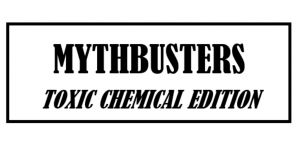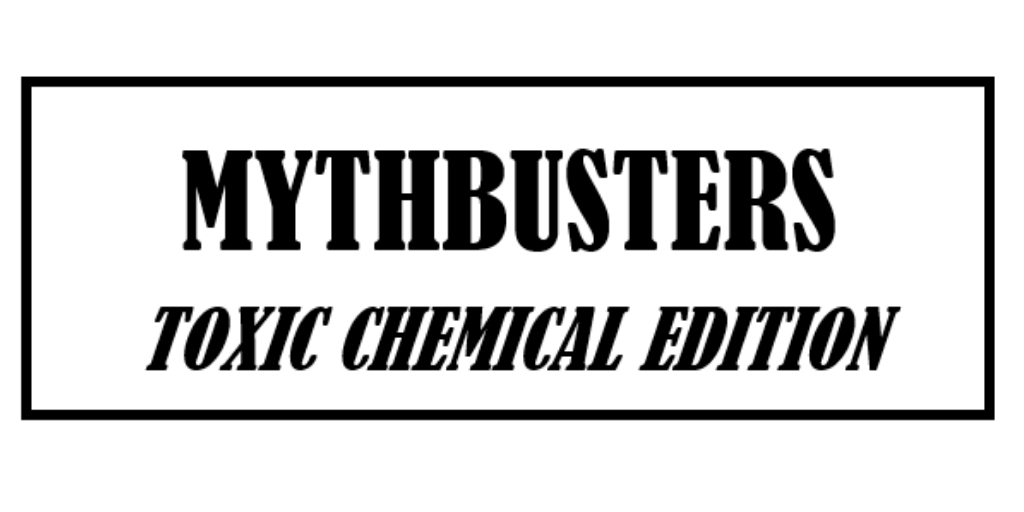
PART 3: Busting more industry-perpetrated myths about new chemicals and worker protection under TSCA
Richard Denison, Ph.D., is a Lead Senior Scientist.
I have been blogging in the last few weeks about myths the chemical industry is perpetrating about the adequacy and legality of the Environmental Protection Agency’s (EPA) recent reviews of the risks that chemicals just entering the market may present to workers. In this post, I address another such myth that, unfortunately, EPA has swallowed hook, line, and sinker. This myth was laid out by one of the industry witnesses at the March 13 House Energy & Commerce Committee hearing on EPA’s failures to protect workers from chemical risks.[pullquote]One wonders when EPA will start doing what Congress told it to do, first in 1976 and then again, with renewed vigor in 2016: Protect workers under TSCA – using TSCA’s authorities to meet TSCA’s health standard, not OSHA’s.[/pullquote]
I’ll get to this third myth in a moment. But let me first try to crystallize what is at stake in this debate. While the Toxic Substances Control Act (TSCA) has always given EPA authority to regulate workplace risks, the 2016 amendments to TSCA strengthened EPA’s authority and mandate to protect workers. TSCA now expressly identifies workers as a “potentially exposed or susceptible subpopulation.” See the definition of that term in paragraph 12 here. TSCA then requires EPA to identify and assess potential risks to such subpopulations when reviewing both new and existing chemicals. Finally, it requires EPA to use its TSCA authorities to impose restrictions on any chemical found to present an “unreasonable risk” – which is TSCA’s health standard – to any such subpopulation.
In a word, TSCA requires EPA to protect workers under TSCA – using TSCA’s authorities to meet TSCA’s health standard, not OSHA’s.
Both before and after the 2016 TSCA amendments, the chemical industry has sought to compel or convince EPA not to regulate workplaces under TSCA, and instead to defer to OSHA. Industry wants this because OSHA’s authority and capacity are severely limited and its legal requirements for regulating toxic substances (“health standards” in OSHA parlance) allow vastly greater risks to workers than do TSCA’s (see my previous post).
Sadly, under the Trump EPA, industry is getting its wish. At industry’s urging, EPA is acting in a manner that is wholly contrary to TSCA – and is less health-protective than even under TSCA before the 2016 reforms.
Now let’s get back to more myth-busting.
Myth #3: Safety Data Sheets and personal protective equipment have been shown to ensure workers are protected from any exposures to the new chemicals EPA is approving under TSCA.
Both industry witnesses espoused this myth at the recent hearing. The second of those witnesses, Tom Grumbles, identified himself only as a past president of the American Industrial Hygiene Association (AIHA) and related groups, failing to disclose his long career working for chemical companies. I’ll examine the claims made in his testimony in this post.
Grumbles asserted – without providing any evidence or citations – that “in his experience” Safety Data Sheets (SDS) and their personal protective equipment (PPE) recommendations are essentially universally employed and universally effective. In a previous post in this series, I already demonstrated why OSHA regulations requiring SDSs and those purported to require the use of PPE fall far short of actually requiring that workers be protected. To summarize:
- OSHA regulations requiring companies to provide an SDS do not impose ANY requirements on employers to implement an SDS’s recommended precautions. To quote the OSHA regulation itself: “[A] recommendation on a safety data sheet by itself would not trigger the need to implement new controls.”
- Other regulations that may require use of PPE give employers inordinate discretion to decide whether or not a workplace hazard exists, and if so, whether use of “appropriate” PPE is “necessary.”
- Any decision by an employer to impose PPE requirements would hinge on the employer evaluating whether or not workers face a significant risk under OSHA’s health standard – which means PPE would only be called for if risks to workers far greater than would be allowed under TSCA were deemed to exist. Absent evidence of such a risk, OSHA regulations permit an employer to conclude that PPE is not necessary.
Importantly, the SDS that EPA reviews when approving a new chemical may not be the same as the SDS a manufacturer relies upon to comply with OSHA standards. And the hazards warned about, and the PPE recommended, by the manufacturer once a chemical enters the marketplace may change. OSHA rules permit a manufacturer to use different definitions of a “hazard” than TSCA requires, and nothing precludes a company from altering its SDS over time.
In another recent post, I presented actual published evidence as well as statements from OSHA itself showing that:
- in the real world SDSs suffer from serious problems even as hazard communication tools, with respect to access, accuracy and completeness, and comprehensibility;
- reliance on workers wearing PPE has major practical limitations, at best exhibits mixed effectiveness in the real world, and unfairly shifts the burden of protection from employers onto workers; and
- PPE is the least desirable option under longstanding industrial hygiene principles recognized by both OSHA and the industrial hygiene (IH) community.
Do OSHA inspection data support the industry’s assertions about SDSs and PPE?
The only part of Grumbles’ testimony even approaching any actual evidence is contained in this statement (emphasis added):
This U.S. Occupational Safety and Health Administration (OSHA) requirement creates an effective PPE selection process that is documented and verifiable. In fact, OSHA statistics support this. The OSHA database of 12 million violations dating back to the 1970s shows less than one percent of violations related to lack of eye protection, lack of general dermal protection, and lack of glove use (or inappropriate glove use), despite the fact that these violations are relatively easy to observe. This confirms that workers are wearing PPE and compliance is likely.
This same claim about OSHA inspections has become a popular refrain of other industry voices as well (see the last sentence here). On scrutiny, this “statistic” simply doesn’t hold water.
First, OSHA and its inspections cover all kinds of industries besides the chemical industry. For example, about half of all OSHA inspections are in the construction industry. Second, the great majority – more than 80% (see p. 92) – of OSHA inspections focus on safety, not health, concerns. And many of the health-focused inspections are directed at problems such as excessive noise leading to hearing loss or, occasionally, acute hazards facing workers, such as dermatitis from corrosive chemicals, not latent effects of chemicals. Grumbles’ citing of a statistic derived from OSHA-wide data for all kinds of industries and concerns is essentially meaningless. Only industrial hygiene inspections focused on workplaces where chemicals are handled would be at all relevant.
Even assuming an OSHA inspector is looking at or might encounter a chemical-focused PPE-related situation – a big assumption – Grumbles’ statistic also ignores both the rarity of actual PPE requirements under OSHA that could result in a violation, and the high bar OSHA faces in establishing that a violation has occurred.
OSHA has issued comprehensive standards which regulate exposures for fewer than 40 chemicals (listed on p.103). Each of these standards requires the use of specific PPE tailored to the hazards of the regulated chemical. But none of these requirements apply to the tens of thousands of existing chemicals OSHA does not regulate or to new chemicals. Where no specific PPE regulation applies, OSHA requires employers to self-evaluate whether their employees face a hazard and, if so, to provide “appropriate” PPE. I have already discussed why these general regulations will only be invoked where employers use their discretion to decide there is a significant workplace hazard and PPE is necessary.
Further, in most cases when a worker is exposed to one of the 470 or so chemicals for which OSHA has a PEL but no specific requirements, if no or inadequate PPE is provided, the agency would more likely cite the employer for failure to use engineering controls to protect the worker (see §1910.1000(e)), rather than failure to provide PPE (and by policy (see pp. 5-7), the agency does not cite both for the same situation).
Finally, for an OSHA inspector to be able to cite an employer for, say, violating an SDS recommendation to provide and make its workers wear gloves when handling a chemical for which OSHA does not have a standard requiring gloves, the inspector would have to show that employees face a significant risk from the chemical exposure and that the employer (or at least its industry) knows that the hazard exists. Obviously, for the new chemicals EPA is reviewing, such evidence would be almost impossible to come by.
Grumbles’ statistic conspicuously omits any mention of violations involving respirators – which begs the question of whether he has omitted data showing a higher rate of OSHA violations involving respirator use. OSHA’s regulations requiring respirator use are more extensive: they apply to the several hundred chemicals for which OSHA has set a Permissible Exposure Limit (PEL), and for which feasible engineering controls are inadequate. OSHA has acknowledged, however, that the great majority of these PELs which were grandfathered in 1970 and based on even older science – are not protective of worker health. And in any case, none of this is relevant here because none of the PELs apply to new chemicals being reviewed and approved under TSCA.
Conclusion
This series of blog posts has exposed several damaging myths long pushed by the chemical industry that appear to be driving the Trump EPA’s negligent and illegal approach to addressing worker risks from new chemicals under TSCA. EPA is shirking its responsibilities under TSCA and instead seeking to shift the burden onto a beleaguered OSHA and onto the backs of American workers.
One wonders when EPA will start doing what Congress told it to do, first in 1976 and then again, with renewed vigor in 2016: Protect workers under TSCA – using TSCA’s authorities to meet TSCA’s health standard, not OSHA’s.












